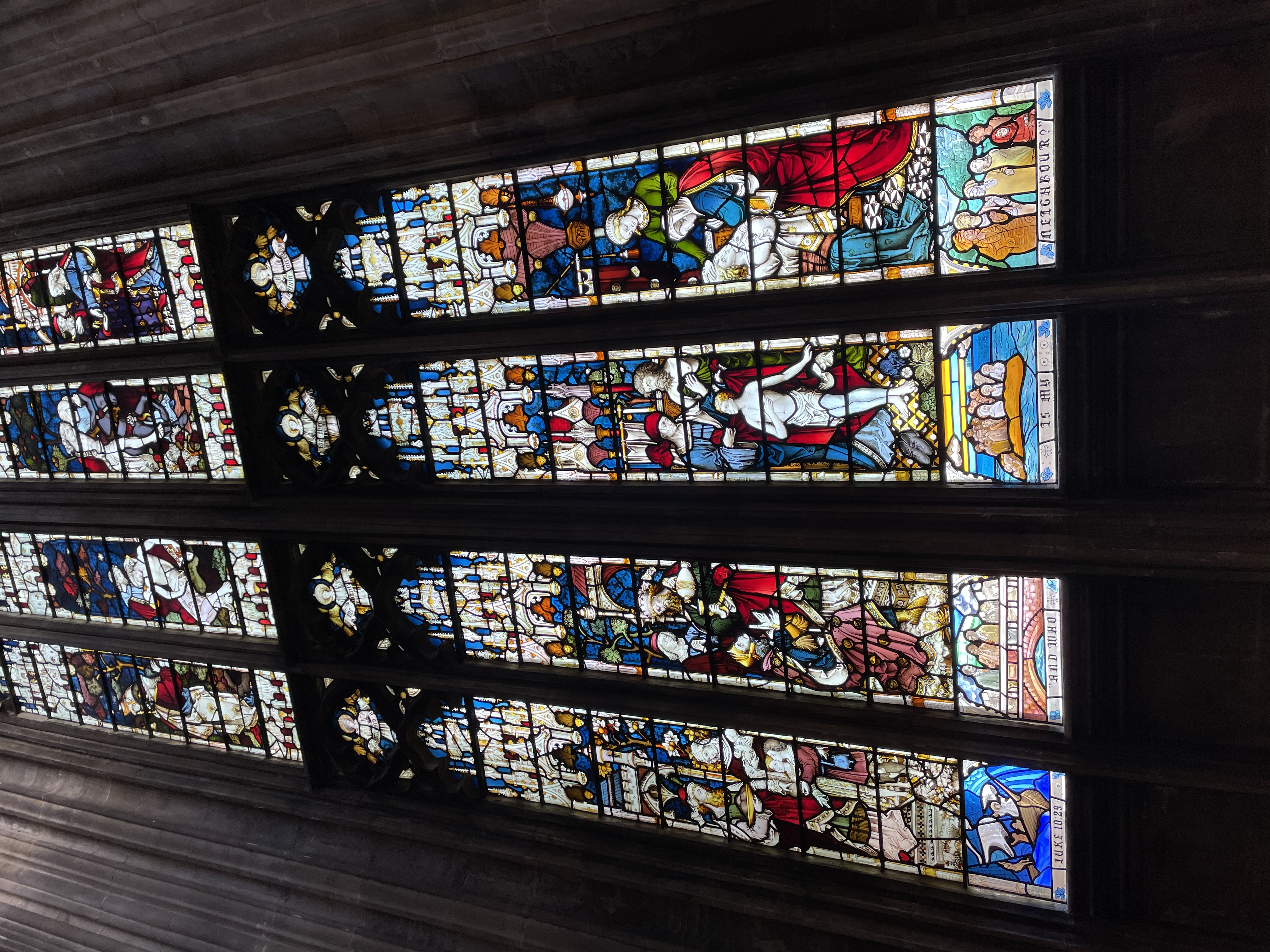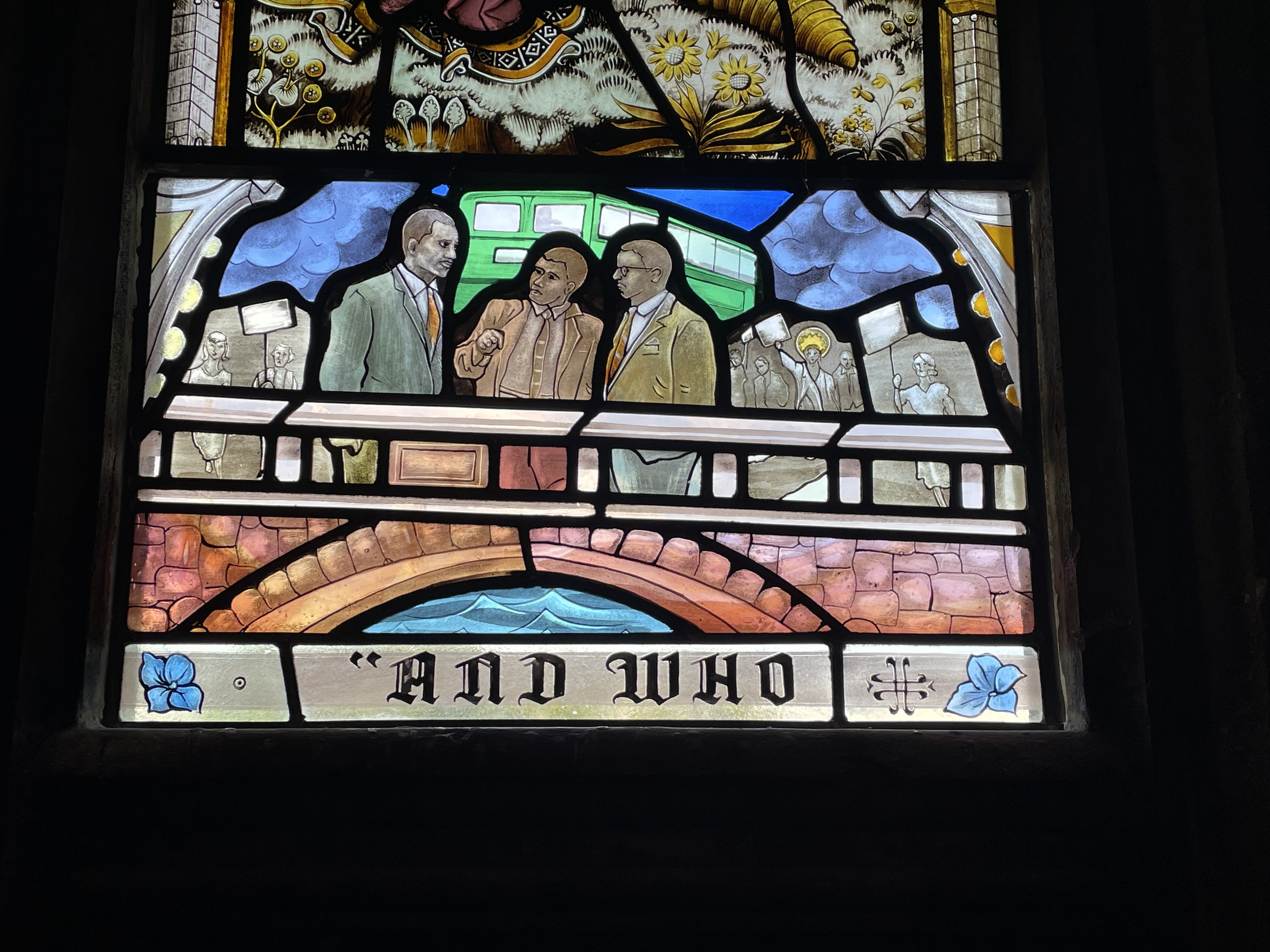 St Mary Redcliffe in Bristol has unveiled four contemporary stained-glass window designs celebrating Bristol’s rich multicultural past and present, including a dedication to the Bristol Bus Boycott.
St Mary Redcliffe in Bristol has unveiled four contemporary stained-glass window designs celebrating Bristol’s rich multicultural past and present, including a dedication to the Bristol Bus Boycott.
During a day celebrating the 60th anniversary of the boycott, the new panels were unveiled, replacing the original replaced its stained-glass, which commemorated windows commemorating slave-trader Edward Colston.
A boycott of Bristol’s bus network ended in August 1963 after the then-operator finally gave way to protestors’ demands, allowing Black and Asian people to be employed as drivers and conductors after they were initially banned. This pivotal moment paved the way for today’s Race Relations Act, which made racial discrimination unlawful in public places.
A competition was launched in 2021 to find new imaginative designs to reflect the question that prompted Jesus to tell the story – ‘Who is my neighbour?’ Consequently, the new window panels, which depict Jesus “in multiple ethnicities to counter the Anglo-centric narrative of ‘white Jesus’” were designed by local doctor, Ealish Swift.
The panels were unveiled after a moving ceremony at St Mary Redcliffe, featuring pop-up poetry from Miles Chambers, a demo by those involved in the Bristol Bus Boycott and their descendants, gospel singing from the Renewal Choir, ballet from the Southwest Dance Centre, and speeches from Rob Pym, commercial director of First Bus, the Rt Rev Vivienne Faull, Rev Dan Tyndall and Deputy Lord-Lieutenant Rev Richard Pendlebury. A First Bus decorated in honour of the Bristol Bus Boycott, was also unveiled shortly after the service, as bells rang out from the church.
A highlight of the day was the panel discussion led by Julz Davis on ‘Why the Bristol Bus Boycott mattered then, and now!’ The panel, which featured conversation from Vernon Samuels, Olympian, and son of first black bus conductor, Sharon Foster, High Sheriff of Bristol, and Councillor Amriah Cole, was followed by a moving ceremony where pioneers of the Bristol Bus Boycott were thanked by representatives from varied industries and institutions from across the region. Each pioneer – or a representative for the family - was given a card, filled with thanks from people around the city. The ceremony started with Guy Reid-Bailey, who sparked the Bristol bus boycott and then fought to desegregate housing the and included daughter of Roy Hackett, who passed away in August 2022, amongst many others.
Speaking about the unveiling of its specially designed stained-glass window, Canon Dan Tyndall, Vicar of St Mary Redcliffe Church said: “We are delighted to have hosted such a significant event for the city. The new designs, replacing those dedicated to the slaver Edward Colston, focus on the question ‘And who is my neighbour?’ It is a timeless question we are continually asking ourselves as we seek to be open and inclusive to everyone; and, it seems to me, to have been at the heart of the Bristol Bus Boycott.”
The window panels were removed after a statue of Colston was toppled in the centre of Bristol in 2020 following the death in the USA of George Floyd. Permission was granted by The Consistory Court of The Diocese of Bristol to replace the windows with Justin Gau, Chancellor of the Diocese, Sating: “The Church of England and the historical behaviour of this parish Church in excusing the life of Colston have a journey of repentance to make. To excuse or ignore the slave trade is a sin. To encourage parishioners to look at a memorial to a slave trader and to be encourage to ‘Go thou and do likewise’ is not only grotesque but entirely contrary to the Gospel command to love one another.”
 She said:
She said:
“The toppling of the statue of Edward Colston and its bundling into the harbour three summers ago marked a turning point in Bristol’s ongoing fight for greater justice and equality. This action brought the city’s long oppressive history of trading in human beings into the spotlight where it should be. These are issues that the Diocese of Bristol which I represent here as Bishop like many local organisations has been aware of, has discussed and attempted to address but has done so often without conviction, energy, or investment.
“On the day that Colston’s likeness sank into the harbour and became a global symbol of change I pledged to act with a renewed sense of urgency and determination:
• To acknowledge and repent of the Church’s past involvement in and benefit from the slave trade.
• To challenge and address institutional racism listening to and learning from the experiences of black, Asian and minority people.
• To recruit and support more black, Asian and minority ethnic clergy, staff, and volunteers.
• To make our churches truly welcoming to everyone, taking responsibility for the need for profound cultural change in our church and
• To work with others in the Diocese of Bristol and in the Church of England to bring these things about.
“That work continues - often much more slowly than I would prefer but today is a reminder that change is underway. And I am encouraged and energised by the creativity, imagination and passion that has been released amongst campaigners, performers, and visual artists to form a new culture of justice and a new narrative of inclusion in this city of Bristol.
“Today this city is marking as we’ve heard the 60th anniversary of the Bristol Boycott. The Bus Boycott which is the subject of the second window. The Bus Boycott window panel includes a clearly recognisable Paul Stephenson and others who spoke on behalf of those campaigning for an end to the employment bar on black and Asian bus crews.
“I acknowledge with shame the opposition to the boycott of the then Bishop of Bristol, my predecessor and of the Council of Churches. The then-bishop, who sided with the City Council and the trade union the TGWU, worked to circumvent Paul Stephenson and others here in the West Indian Development Council. The churches issued a statement at the time which is shocking in its racist presuppositions. They said: “We seriously regret that what may prove an extended racial conflict arising from this issue has apparently been deliberately created by a small group of West Indians professing to be representative.
“The Bus Boycott of 1963 is a reminder that my church abjectly failed to see Jesus in those who were exploited, marginalised, oppressed and I am sorry and shamed.
“Under pressure from national politicians, the general manager of the Bristol Omnibus Company announced an end to (overt) discrimination. The boycott was called off 28 August 1963, the day of Martin Luther King Jr’s ‘I have a dream’ speech. Within a few weeks, four Black and Asian men were appointed as conductors.
“I am very grateful indeed to Canon Dan Tyndall for his leadership within the church and parish of St Mary Redcliffe, and to Ealish Swift, the artist who has so wonderfully and powerfully responded to the brief to create these four beautiful new windows.
“Ealish has located Jesus amongst the protesters, and amongst the diverse group of neighbours in the second and fourth panels. Through these windows, we are told of the dream and hope of justice. May that dream continue to convict, challenge, and inspire and inspire us to find Jesus in those who are being exploited, marginalised, and oppressed in our world today.”
You can watch the full service below:
Here's a gallery of images from the day: